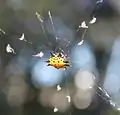Gasteracantha cancriformis
Gasteracantha cancriformis[2] (Spinybacked orbweaver) is a species of orb-weaver spider (family Araneidae). It is widely distributed in the New World.[1]
| Gasteracantha cancriformis | |
|---|---|
 | |
| Female | |
| Scientific classification | |
| Kingdom: | Animalia |
| Phylum: | Arthropoda |
| Subphylum: | Chelicerata |
| Class: | Arachnida |
| Order: | Araneae |
| Infraorder: | Araneomorphae |
| Family: | Araneidae |
| Genus: | Gasteracantha |
| Species: | G. cancriformis |
| Binomial name | |
| Gasteracantha cancriformis | |
| Synonyms[1] | |
| |
The genus name Gasteracantha derives from the Greek words γαστήρ (gaster, "belly") and ἄκανθα (acantha, "thorn"), while the specific epithet cancriformis derives from the Latin words cancer ("crab") and forma ("shape, form, appearance").
Description
Females are 5–9 millimetres (0.20–0.35 in) long and 10–13 mm (0.39–0.51 in) wide. The six abdominal spine-like projections on the abdomen are characteristic. The carapace, legs and underside are black with white spots under the abdomen. Variations occur in the colour of the upperside of the abdomen: a white or yellow colour with both featuring black spots. A white upperside can have either red or black spines while a yellow upperside can only have black ones. Like with many other spiders, males are much smaller (2 to 3 mm long) and longer than wide. They are similar to the females in colour but have a gray abdomen with white spots and the spines are reduced to four or five stubby projections.
This species of spider does not live very long. In fact, the lifespan lasts only until reproduction, which usually takes place in the spring following the winter when they hatched. Females die after producing an egg mass, and males die six days after a complete cycle of sperm induction to the female.
Distribution and habitat
Gasteracantha cancriformis is native to North America, Central America, the Caribbean and South America and India. It has been introduced elsewhere, including Hawaii.[1]
G. cancriformis is seen to coexist within and on the edges of the colonies of other colonial orb-weaver spiders, mainly Metepeira incrassata. M. incrassata is known to form large colonies ranging from few hundreds to few thousands of spiders, and their colonies often accommodate other species of orb-weavers including G. cancriformis.[3]
Gallery
 Eating a butterfly
Eating a butterfly Ventral view, with spinneret visible
Ventral view, with spinneret visible In Miami
In Miami In Miami Lakes
In Miami Lakes In Ecuador
In Ecuador In Novo Hamburgo (southern Brazilian population), with focus on the web
In Novo Hamburgo (southern Brazilian population), with focus on the web On a tufted web in Houston, Texas
On a tufted web in Houston, Texas Color variation, near Houston
Color variation, near Houston Underside of orange specimen, showing spinner and thread. For scale, band in background is 6 mm wide. Near Houston
Underside of orange specimen, showing spinner and thread. For scale, band in background is 6 mm wide. Near Houston
_-_ventral_view.jpg.webp) Ventral view, in North Carolina
Ventral view, in North Carolina
See also
References
- "Taxon details Gasteracantha cancriformis (Linnaeus, 1758)", World Spider Catalog, Natural History Museum Bern, retrieved 2016-04-28
- Peters, A. (2002). "Gasteracantha cancriformis". animaldiversity.org. Animal Diversity Web.
- Hodge, Margaret A.; Uetz, George W. (September 1996). "Foraging advantages of mixed-species association between solitary and colonial orb-weaving spiders". Oecologia. 107 (4): 578–587. doi:10.1007/BF00333951. ISSN 0029-8549.
Further reading
- Eberhard, William G. (2006): Stabilimenta of Philoponella vicina (Araneae: Uloboridae) and Gasteracantha cancriformis (Araneae: Araneidae): Evidence Against a Prey Attractant Function. Biotropica 39(2): 216-220. doi:10.1111/j.1744-7429.2006.00254.x
External links
![]() Media related to Gasteracantha cancriformis at Wikimedia Commons
Media related to Gasteracantha cancriformis at Wikimedia Commons